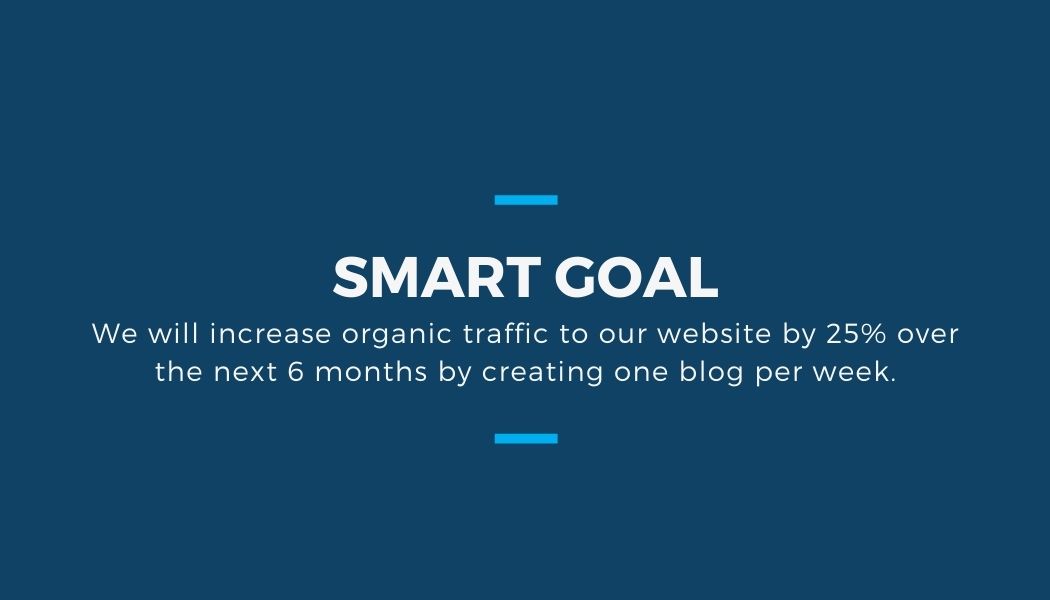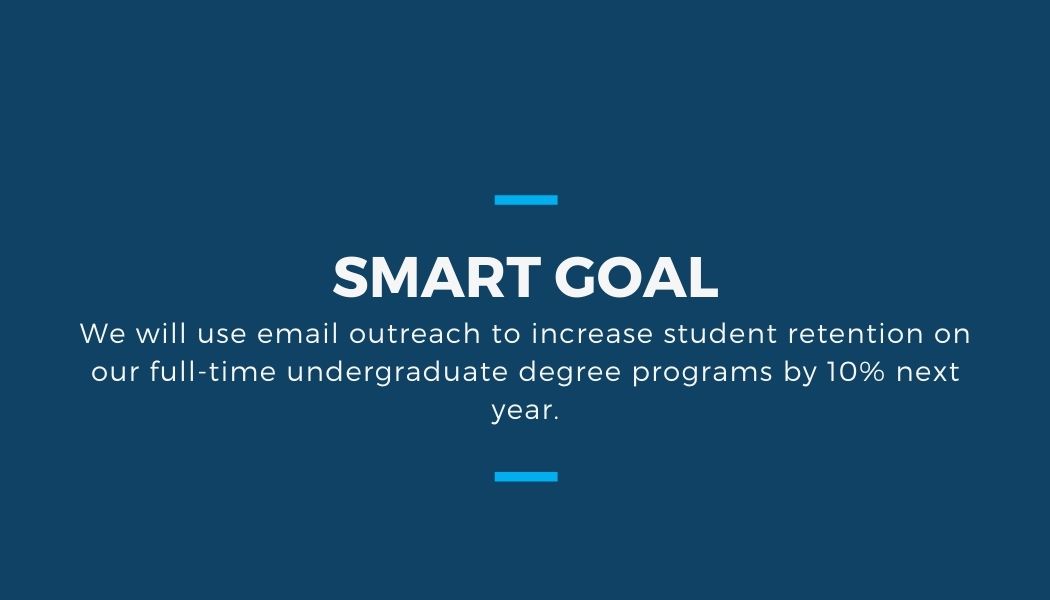
On a basic level, your school probably already knows what its overall goals are when it comes to marketing and student recruitment. Improve your visibility online, engage with your community, attract more students. Seems simple enough, right?
Until, of course, you start to think about each of these things in a bit more detail. How do we improve online visibility, and on what channels? What tactics can we employ to better engage our school community, and how do we measure that? How many more students do we want to attract, and can we realistically expect to achieve that target using our current resources?
Without clarity, the objectives you define for your team may prove to be overly ambitious, irrelevant, or just impossible to measure.
Fortunately, there are some tried and tested tricks marketers use to set clearer goals, and one of the most common is SMART criteria. Keep reading to learn more.
What are SMART Goals? An Overview for Education Professionals
Originally defined in a 1981 issue of Management Review by George T. Doran, SMART criteria is a school of thought which posits that all business objectives should be:
– Specific
– Measurable
– Attainable
– Relevant
– Time-bound
This is the most common breakdown of the acronym, although you will sometimes see the wording changed slightly (Achievable instead of Attainable, Timely instead of Time-bound). Different companies and professionals have also introduced their own variations over the years which put a different spin on the criteria, such as substituting Achievable for Aspirational or Actionable.
For the purpose of this blog though, we will look at the most widely used version. Let’s take a deep dive into what each letter means, one by one.
Specific
Too often, it’s easy to set goals for your organization that are too vague, whether in relation to what you want to accomplish, how you will accomplish it, or when you aim to accomplish it.
Using SMART criteria encourages you to strive for clarity when setting goals, and avoid defining objectives that can be misunderstood. For illustration, let’s look at a simple, universal goal for most schools:
“We will increase enrollments.”
Obviously, this fails the specificity test. If you put it to your team, they may be left asking themselves:
- How many more enrollments?
- On what programs and courses?
- Over what time period?
- How will we increase enrollments?
That’s where the other elements of the SMART goals system come in…
Measurable
Making sure your team’s success can be measured is crucial, particularly when it comes to results-driven areas like student recruitment and digital marketing.
Measurement can come in two forms: tangible results which show clearly that you have achieved your objective, or key performance indicators (KPIs) which serve as signposts that you are making progress when looking at more subjective goals.
For the first category, let’s return to our previous example. Rather than simply:
“We will increase enrollments.”
…your team needs to clearly define how many more students it wants to attract:
“We will increase enrollments by 20%.”
You now have a clear, unambiguous target for your team to work towards, and you will be able to assess whether you have achieved it by seeing how much your enrollment grows.
Of course, some other objectives might be more difficult to measure. For example, say your marketing team has been tasked with making your Facebook presence more engaging. This is a very subjective goal, as what one person finds engaging on social media is not necessarily the same as what another person does.
To make it more measurable, you need to attach it to a clear KPI. Engagement rate (the percentage of the total people who see a post that engage by reacting, clicking, commenting, or sharing) would be a good indicator of success. So, the goal becomes:
“We will increase our average engagement rate on Facebook to 2%.”
This gives your team a tangible metric by which to define its success.
Attainable
This is arguably the most important question to ask yourself when setting a SMART goal for your student recruitment strategy. Given your resources, expertise, and current position in the marketplace, can you really expect to accomplish what you are proposing?
There are two elements to this. First, you need to make sure that the goal you are setting yourself is realistic. If your team has managed to increase enrollments 5% each year for the past 5 years, you shouldn’t suddenly expect a jump of 20% unless something significant has changed.
The other thing you need to consider is how you plan to achieve your goal. If you are aiming to increase enrollments, what new tactics will you employ to get your results? For example, if your school has not been investing in Facebook advertising but is now planning to run campaigns, your goal may become:
“We will use Facebook advertising to increase enrollments by 10%.”
Without finding a way to improve your approach, you will likely be setting yourself up for failure. By ensuring you are setting a reasonable target backed with appropriate resources, your staff will feel like they are being given a fair challenge that they will be motivated to accomplish.
Relevant
Any objective you set should have a real beneficial outcome for your student recruitment efforts, and failing to focus on relevance could lead you to waste time on strategies and approaches that don’t really benefit you.
For example, many schools are currently looking to build their presence on TikTok, so this may be a goal you have in mind. But if you’re a career college that mostly recruits mature 30+ students, establishing yourselves on TikTok will likely not result in much traction for your recruitment given the younger demographics that make up the bulk of its audience.
Even with more universal goals, like the enrollment objective we have been building throughout this post, relevancy isn’t a given. For instance, if your school runs both 3-year degree programs and short professional development courses, the longer courses might drive more revenue and be a higher priority. So, your goal becomes:
“We will use Facebook advertising to increase enrollments in our degree programs by 10%.”
You now have a specific, measurable, achievable, and relevant goal. Just one more step!
Time-Bound
The final step is somewhat self-explanatory. Whatever your goal is, it needs to be attached to a specific timeframe that your team is comfortable committing to accomplishing it within.
The time will likely be defined by your enrollment cycles, or by the time and resources your team needs to accomplish a task.
Thus, you might complete our goal by stating simply:

And there you have it. You have developed a clear SMART goal for your school.
SMART Goals in Education Marketing Strategies
SMART goals can be employed across your education marketing strategy. You will likely have several goals across different digital channels and platforms, but it may be helpful to consider them in the context of the enrollment journey.
SMART Goals in the Awareness Stage
At the awareness stage, you will mostly be looking to build your school’s online visibility and the reputation of your brand. Your goals will be focused on KPIs which will indicate that you are reaching a larger audience than before, such as website traffic and reach on social media.

SMART Goals in the Consideration Stage
During the consideration stage, you will be looking to translate increased visibility and engagement into concrete leads for your admissions team. This means generating inquiries, newsletter signups, information session bookings, and other activities which indicate a prospect is serious about their interest in your school.

You also want to ensure you are engaging your prospects, and using your digital marketing initiatives to nurture them. With that in mind, you might have goals built around KPIs that indicate more people are reading your blogs, engaging with your social media posts, reading your emails, and doing other things which indicate they are actively exploring your offerings as they progress through the funnel.
SMART Goals for the Decision Stage
There is one obvious SMART goal your team will likely have at the Decision stage: generating applications. At this point, your team will want to see all of its efforts further up in the funnel translating to more potential students for your courses.
Depending on what kind of digital marketing initiatives you have engaged in, you may also want to set SMART goals for application generation from different channels, so that your team has clear objectives to show the ROI of its efforts.

SMART Goals at Enrollment
Once applications have been accepted, your goals will become more about attrition and retention. Your team might look to increase its applicant-to-student ratio, or increase its retention once students begin their courses.

While it’s less explicitly tied to your digital marketing efforts, you can still find correlation between the two, particularly if you are devoting marketing efforts to providing resources for incoming and current students.
SMART Goals for Student Recruitment in Admissions
In addition to marketing, the SMART goal system could have applications across your admissions team’s student recruitment strategies. Your team can use it to set your objectives for:
- Nurturing more leads to application
- Improving the volume and productivity of your follow-up activities
- Increasing the speed of your follow-up activities
- Turning more applicants into admitted students
To track the success of these goals, CRM and marketing automation reporting could be your best friend. Through both out-of-the-box and customized reports, you can evaluate the success of your efforts on a regular basis during a defined time period.
Example: The Speed to Lead report in Mautic by HEM. This report tracks the average follow-up time of your admissions staff with leads, and the percentage followed up with. If you have set goals around improving the timeliness of your follow-up, a report like this could help you keep an eye on your progress.

Reviewing and Redefining Your School’s SMART Goals
Of course, one issue with setting clearly defined goals is that you never know what the future will bring. An obvious example of this in the education sector is the fallout from the COVID-19 pandemic, which has seen many schools struggle to meet the enrollment targets they have set for themselves.
Situations like this underline the need to review and refine your SMART goals on an ongoing basis. You might also find more everyday blockades to reaching your goals, such as time management and resource issues, or your results simply not being as good as you expected.
Your SMART objectives can be fluid, and adjusted to allow for changing circumstances. The important thing is that you set your school’s team a clear roadmap of where you need to go, and what you need to do to get there.






